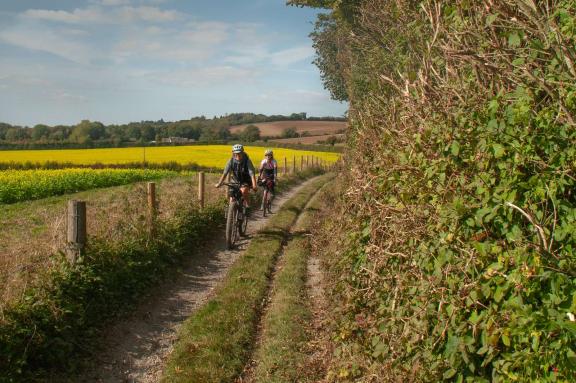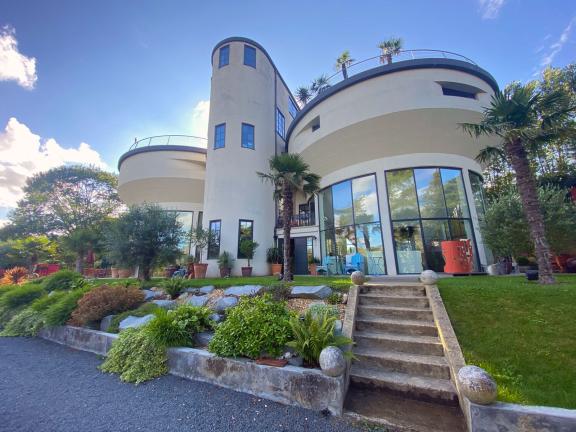This road ride explores to the north, almost reaching the market town of Faversham. Starting with a steep climb up onto the North Downs, it soon enjoys the more gradual gradients and sweeping country lanes, passing through rolling farmland and orchards.
There are some interesting properties to see along the way, as you pass Belmont House & Gardens and Doddington Place Gardens. Local pubs and cider farms offer produce made from the very fields you are cycling through, providing the full Kentish experience.
Heading east, leave the village centre of Lenham behind you. A little way down this road is the humble source of the Great Stour river if you wish to witness where this great river starts its long journey to the North Sea.
Your own journey continues with a crossing of the A20 road, where it then climbs the steep hillside of the North Downs, leaving the hum of civilisation behind.
As you climb the hillside, resist the temptation to join National Cycle Network 17, whose signs would otherwise guide you onto some rough tracks that dive into a dark tunnel of trees. It may avoid the steep hills and is a very enjoyable trail on two wheels, but it’s not suitable for road bikes, so instead dig deep and continue your journey upwards along the smooth road instead.
Hill conqueror
The sight of a concrete water tower confirms you’ve conquered the hill, as you continue along a singletrack road along the top of the hill. When the high road-side hedges that shelter you along this road end, you are greeted by huge views across the fields of crops, stretching off far into distance in all directions.
The lovely Bowl Inn pub along here provides a great stop should you be in need of refreshments. Otherwise, continue onwards and downwards. The glorious sweeping road is sheltered from the west by woodland, while open fields to the east provide more wonderful unhindered views, providing a more than worthy reward for your earlier efforts up the hill.
Nestled in this lush green valley is the lovely St Mary’s church in Stalisfield, lying tucked away in the trees by a lone house, as you continue a pleasant route along the peaceful valley bottom. After a few houses and farm buildings begin to appear, prepare yourself for an imminent climb which is fast approaching.
It’s not very long, but Haywards Hill is certainly steep enough to test most riders’ leg strength and mental determination. After the effort, though, is an opportunity to rest, with a visit to Belmont House which awaits you at the top.
This elegant 18th century neo-classical house commands stunning views over the surrounding estate and the rolling Kentish North Downs. Steeped in history, this unique house contains mementos of the family’s travels and history (playing a leading role in the development of the British Empire) along with delightful gardens and grounds of more than 3,000 acres.
Belmont House and Gardens
Belmont House is open from April through to the end of September, where self-guided tours are available on Tuesday and Thursday afternoons, and guided tours on Sundays and bank holiday Mondays.
The gardens are open throughout the year, from 10am until dusk and there are numerous activities going on through the year, from spring fairs to open air theatre productions and seasonal events. The gardens consist of a walled garden, pinetum, wooded areas, formal lawns and a large kitchen garden.
Located in the courtyard beneath the clock tower, the Old Stables Tea Room is open all year round on a self-service basis. Visitors are welcome to make themselves a tea or coffee using an honestly cash-only box as payment.
The route now descends along the side of the Belmont Estate, offering wonderful views across the grounds as you go, and delivering you to the lovely village of Painters Forstal. The village takes its name from Painter’s Farm, a 16th-century farmhouse on the edge of the village; Forstal means ‘the land in front of the farm’.
Situated on the junction on an ancient drover's road, and now close to the M2 motorway, The Alma pub has been welcoming patrons since 1837. Owned by Britain’s oldest brewer, Shepherd Neame, it offers a warm welcome and lovely food and drinks, along with a nice garden to relax in or enjoy a game of bat and trap – for an authentic Kentish pub experience (and their excellent Early Bird Ale)!
Bat and trap
An English bat-and-ball pub game played between two teams of up to eight players, involving placing a heavy solid-rubber ball on one end of a ‘trap’ (low wooden box) with a simple see-saw mechanism.
Each player in turn on the batting side hits the opposite end of the see-saw lever with a bat, to propel the ball into the air, and then, using the same bat, attempts to hit the ball between two 7-foot-high posts situated 21 yards away.
The bowling side stand behind and between the posts and if any of them catches the ball before it hits the ground the batsman is out. The batsman is also out if they fail to hit the ball between the posts.
After each successful hit, one fielder (the one whose turn it is to bowl next), returns the ball to the batting end by hurling, tossing or bowling it back towards the trap, attached to the front of which is a small square target, or ‘wicket’, hinged at the bottom. If the bowler hits the wicket with the ball, to knock it flat, the batsman is ‘bowled out’. If the bowler fails, the batsman scores one run and continues to play.
Once all the members of the first batting team are out, the batting and bowling teams change places and the game continues until all players on both sides have batted.
The countryside is delightful here, with yellow fields of rapeseed flowers in the summer, lush green grass verges with wildflowers and huge blue skies with fluffy white clouds and acres of orchards bursting into pink and white blossom in spring.

Ride past vast fields of yellow rapeseed under huge blue skies
Sample some cider
In September the apples from the orchards are pressed and you can purchase some amazing Kentish cider from Pawley Farm in Painters Forstal. There is no visitor centre and not much to see at this working farm, but you may be lucky enough (or organised to call ahead) to meet the enthusiastic owner and get a tour and tasting.
Heading out of the village it couldn’t be more quintessentially Kentish, with fields of hops, vines and a farm selling cider from the apples grown in the orchards beside this very road. Typical Kentish buildings are dotted around, with weatherboard-clad houses and the tall conical shaped roofs of oast houses lining the road.
These iconic oast houses were designed for kilning (drying) hops as part of the brewing process. The buildings consist of a rectangular building (the ‘stowage’), one or two stories high, and have one or more kilns in which the hops were spread out to be dried by hot air rising from a wood or charcoal fire below. The drying floors were thin and perforated to permit the heat to pass through and escape through a cowl in the roof which turned with the wind.
Known as oast houses (oast means kiln) in Kent and Sussex, the same buildings in Surrey, Hampshire, Herefordshire and Worcestershire are called hop kilns.
You will probably hear the rumble of the motorway ahead, but the route turns back along quiet back lanes before descending beneath the motorway to the bottom of the hill. Directly ahead is the dramatic Lime Works home and studio of the sculptor Jeff Lowe.
This unique property was created by converting an old water softening plant which was built in the 1930s. After being judged unfit for purpose and left empty from the ’40s, it was considered so ugly that Scots pines were planted around it to hide the eyesore.
Beauty is on the eye of the beholder though and when Jeff Lowe saw its unique structure and materials, and art deco lines, he used his vision and flare to transform it into an amazing home and studio for himself.
The route continues onwards and upwards and then plunges into the depths of vast orchards. You make your way between the crops along concrete farm tracks, which are always a pleasure to ride through. It can be a little rough and even scattered with farming detritus. If you happen to be on a delicate road bike feel free to continue on Rushett Lane and keep taking left turns until you re-join the route and pass over the motorway.

Sculptor Jeff Lowe transformed this old water softening plant into a home and studio. Photo: Jeff Lowe
Doddington Place
Descending into the village of Newnham, there is another nice Shepherd Neame pub, The George Inn, to the left if you are in need for refreshments or a rest, or stay on course to the next attraction on this route, Doddington Place.
This has been home to the Oldfield family for a century. It was originally built around1860 for Sir John Croft of the port and sherry family. The gardens still evoke the Edwardian spirit, and offer several different themes, including a woodland, sunken and rock garden among others, available for you to explore and enjoy.
There is also a great tearoom (open Wed-Sun 9am-3pm) with local teas and home-made cakes. You are also welcome to have your own picnic in the park, but not in the gardens and there are Classic Car meets here on every 3rd Sunday of the month from 10am.
https://www.doddingtonplacegardens.co.uk/
If you miss the tearoom or fancy something more substantial, The Chequers Inn, a lovely 14th century coaching inn, is just down in the village of Doddington. This is your last chance for refreshments before the end of the ride.
Hopefully refreshed and refuelled now you’ll have adequate energy to power you up into the hillside once more. The quiet singletrack road winds its way between the rolling fields and woodlands, passing sleepy hamlets and farms that never seem to sleep.
Some short, sharp dips and rises in the road bring you to decision time at Flint Lane. The route heads westbound along a quiet, little used tree-lined singletrack lane that descends the steep escarpment along a fairly rough road surface.
If you’d prefer an easier and faster descent, turning left instead will bring you to the more maintained, and busier, Faversham Road downhill and straight back Lenham. Whatever you choose, you’ll soon be back in the village centre, enjoying the welcoming facilities on offer.
Disclaimer
All routes are followed at a rider’s own risk. These routes are intended to be general guides: please observe all road signs, waymarks and other specific on-route instructions. Neither Cycling UK nor individual route authors can be held responsible for any errors or consequences that arise from using this route information. Essentially: go out, be sensible, have fun. If you believe there is an important issue with this route then please report it using the button below.
Supported by

